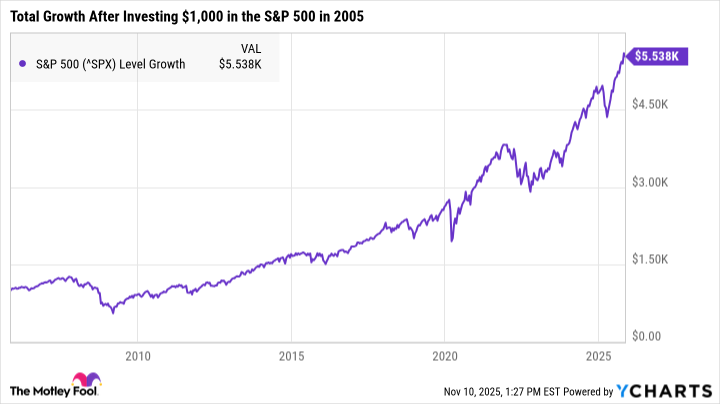The S&P 500 (^GSPC +0.32%) is a powerhouse of an index, and the last couple of decades have been particularly lucrative.
Investing consistently over decades is one of the most effective ways to maximize your earnings while limiting risk, and the longer you allow your money to grow, the more you can potentially earn. If you had invested in an S&P 500-tracking fund 20 years ago, here's approximately how much you'd have today.

Image source: Getty Images.
How far will $1,000 go in the S&P 500?
Perhaps the best part about investing over the long term is that it helps small amounts go further. A one-time investment can grow exponentially over decades, and if you can afford to invest small amounts consistently, you could earn even more.
Since November 2005, the S&P 500 itself has earned total returns of around 454%, as of this writing. If you had invested $1,000 in an S&P 500 index fund or exchange-traded fund (ETF) back then, you'd have more than $5,500 by today.
This figure assumes you made a one-time contribution without investing anything further. If you can swing it, investing small amounts regularly can help your money compound faster.
Over the last century, the total return of the S&P 500 has produced a compound annual growth rate of around 10% per year. At that rate, if you were to invest $100 per month, you'd have close to $70,000 after 20 years. After 30 years, you'd have nearly $200,000, all other factors remaining the same.
How dollar-cost averaging can limit risk
Making a one-time investment can help your money grow over time, but it also means risking that you're investing at a less-than-ideal moment. If you only buy at record-high prices and never at the market's lowest points, you could be paying more than necessary for your investments.
At the same time, however, trying to time the market and only invest at the low points is also risky. The longer you wait to buy, the more valuable time you're losing for your money to grow. A smart middle ground, then, is to dollar-cost average your investments.
With dollar-cost averaging, you're investing the same amount at regular intervals throughout the year -- whether it's monthly, quarterly, or whatever schedule you choose. When you invest regularly, you'll inevitably end up buying at both high and low prices. Over time, this can balance out some of the price swings.
If you can only afford to make a one-time contribution, that's far better than nothing. But if you're able to invest even a little on a consistent basis, that can help you earn far more over the long haul.







